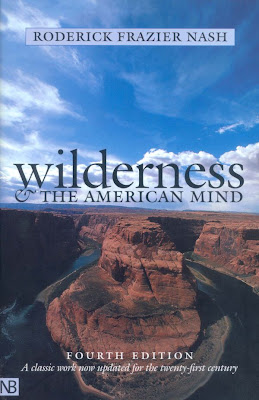Taking a break from the computer and the endless array of blog posts gives one an opportunity to reconnect with the written word in a different way. (For full disclosure, I hate reading on the computer – so really have to slog through text heavy posts and articles…) A couple of interesting books that I’ve worked through in the past month couldn’t be more different – but somehow, in the very Gaian way, are related. The first – which I picked up after hearing the amazing Paul Stamets speak, is his great book Mycelium Running. Second, which I picked up for a steal in a used bookstore on a recent trip to Mt. Shasta, is ‘Wilderness and the American Mind’ by Roderick Nash.

:: image via Yale Univ. Press
While my copy was not the much sexier and updated 4th edition seen above, it is sometimes nice to read the original, being able to place the thought in the context of publication – in this case the 1967 version. While not necessarily breaking any new ground, this is one of the most comprehensive studies of the history of our relationship with Wilderness from the uniquely American perspective, and offers insight into our cultural baggage that influences our relationship with nature and the world even today.
Encompassing an arc of history from the early settlers to the 1960s, it’s fascinating to see the linear narrative of Wilderness and our shift of ideology from fear, to celebration, to exploitation, and finally to our current state of tension that still exists today. Starting with our European ideas of wilderness expressed by early settlers – the fear of the dark primeval forest and it’s dangerous denizens is shaped by an utter lack of true Wilderness that these people had to experience in settled Europe. This is contrasted by Nash in the views of Eastern cultures that had a more subtle and less binary view of wilderness.
The shift from pilgrim fear to pioneering domination shaped the next era, as wilderness was meant to be dominated as an expression of our growth and western expansion. Civilization was countered with a desire for escape to the surrounding pastoral areas. The western push opened up a view of untouched scenery that amazed the viewers with it’s rugged beauty and became a defining element of the ‘American’ wilderness as like none other in the world.
Following such writers and explorers such as the transcendentalits Ralph Waldo Emerson and Henry David Thoreau, the explorer and wilderness fighter John Muir, wildlife watchers such as John James Audubon, and also the defining guidance of Frederick Law Olmsted in his support of the protection of Yosemite in the 1860s. Building on the work of urban parks as places of the respite in cities to restore the health and vigor of residents, the large parks provided a national analog in being able to provide a counterpoint to development and need protection from the mental stress that results from our industrious society. His report on Yosemite in 1865 included the declaration that: “the enjoyment of scenery employs the mind without fatigue and yet enlivens it; and thus, through the influence of the mind over the body, gives the effect of refreshing rest and reinvigoration to the whole system.” (p.106)
Read Part II: Wilderness, Continued…




on a related note, i’m reading michael pollan’s “second nature: a gardener’s education”…it being that time of year and all…and he sets forth a position that we landscape architects will find rather sympathetic. we need to abolish the old us/them mentality of the “wilderness ethic” and instead develop a “garden ethic”. it is in the winter section of the book, toward the end, if you want to dig in.
B. Great book… one of those I gave as a gift for a couple of years before cracking it open and reading it for myself. It’s interesting to see this baggage we still have with wilderness – and how the idea of the garden ethic fits into the landscape ideology more fittingly. Definitely worth a post.